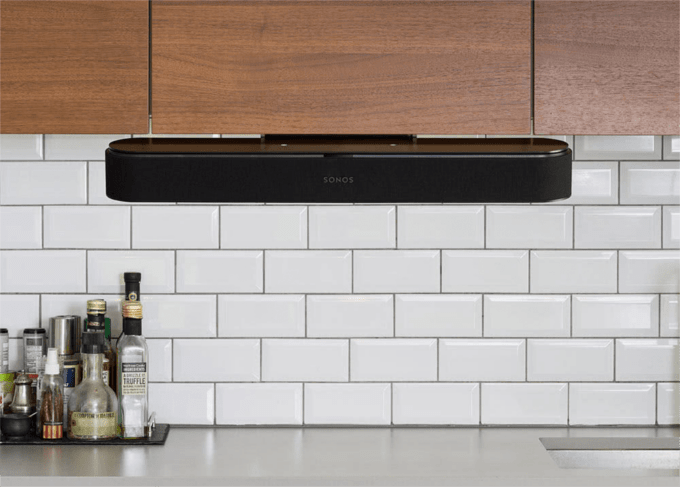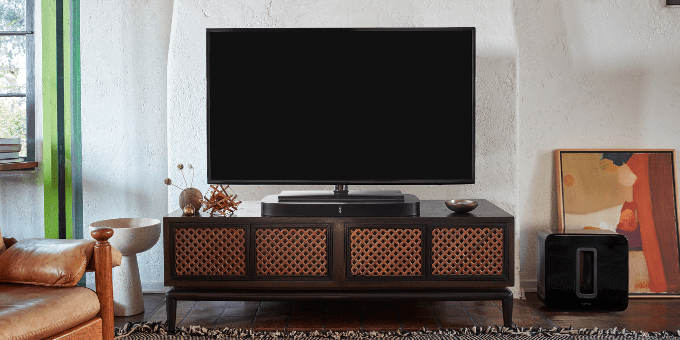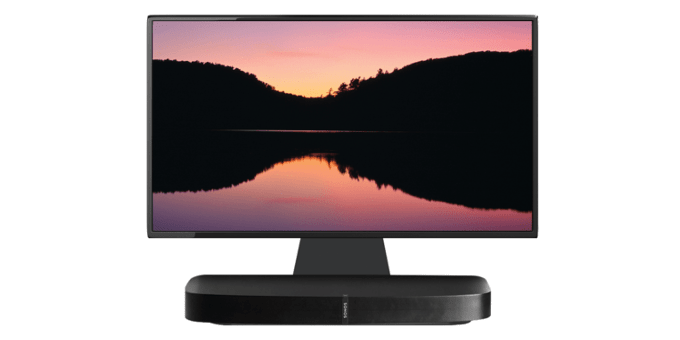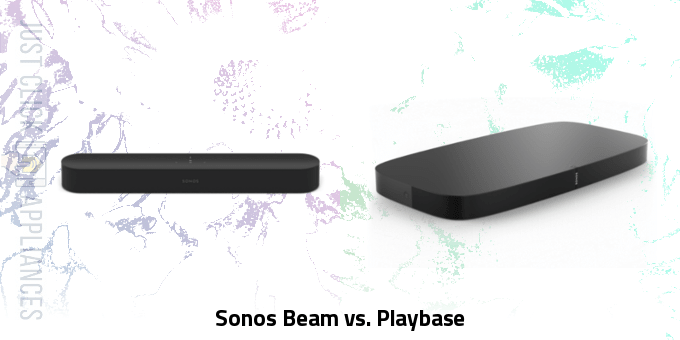While the Sonos Playbase will blow you away with its high-fidelity audio, the Sonos Beam offers similar quality in a compact design that will fit in seamlessly in some of the smallest of rooms.
Let’s take a look at the Sonos Beam vs. Playbase to help you figure out which Sonos smart speaker will make the perfect addition to your home theater system.
Sonos Beam vs. Playbase — Differences
Difference #1: Sound Quality – One of the most important aspects of any smart speaker is the sound quality. While having the ability to stream music over WiFi and enhance your television audio at will is a nice perk, it doesn’t mean much if the sound quality isn’t on point.
The difference in sound between the Sonos Beam and the Playbase is certainly immediately noticeable.
With one tweeter, four mid-woofers, and an amplifier for each, the Sonos Beam delivers respectable sound.
However, that sound is completely outclassed by the Playbase just due to the audio internals that the other speaker features. With three tweeters, six mid-woofers, one woofer, and ten amplifiers, it will blow you away with the depth of sound that it provides.
The Sonos Beam is an excellent device all around, but the Playbase is king of audio when push comes to shove.
Difference #2: Connects to TV – As mentioned above, both the Sonos Beam and Playbase connect directly to your TV, but they do differ in the way that they transmit their data.
The Playbase plugs in via an optical cord, making the process extremely simple. No need to read any instructions – just plug it into your TV and you’re ready to go.
The Sonos Beam, on the other hand, is a little more complex. Because the Beam features Amazon Alexa control built into the speaker itself, you’ll have to connect it to your TV via an HDMI-ARC connection. This is slightly different than a traditional HDMI, and is responsible for syncing the audio and picture. It’s also ultimately responsible for automatically pairing your TV remote to your speaker.
If your TV is older than 5 years, it’s likely that the HDMI-ARC port isn’t present. In that case, you can just use the optical audio adapter in order to connect it to your television — just keep in mind that the Alexa controls for your TV will not be active.
Difference #3: Voice Control – The Playbase can be controlled by external Amazon Alexa devices like the Echo or Echo Dot. The Sonos Beam, on the other hand, has Alexa built-in and doesn’t need any external equipment to respond to your commands.
It’s important to note that the Sonos Beam will always be listening through the microphone in order to respond to your commands, and that can be disconcerting for some owners. Fortunately, there’s an option to mute the mic for greater privacy — a feature which is indicated by an LED, so that you’re aware of whether or not your Beam is active. Sonos values your privacy, and the hardwired connection ensures no one’s listening when you have the microphone turned off.
Difference #4: Bluetooth LE – The Sonos Beam uses a Bluetooth Low Energy (BLE) connection in order to save power while setting up the device, while the Playbase does not have this feature. In day to day use, this difference shouldn’t have a major effect over your decision as the audio transmission is not supported over BLE, but it’s still a part of the installation process and worth keeping in mind.
Difference #5: Design – The design of the Sonos Playbase and Beam are drastically different. While the Beam features a traditional long and thin soundbar design, the Playbase looks a lot more like a square. The Playbase is also significantly heavier, with a weight of around 19 pounds versus the 6-pound weight of the Beam.
Because of these differences in design, they will also differ in how they are mounted. The Beam works when placed on your TV stand or when mounted to a wall with the custom-designed wall mount, just as you’d see with most other soundbars.
The Playbase, however, works a lot better situated right underneath your TV. Its low profile design allows it to blend in perfectly — providing top-quality audio without making its appearance obvious. It’s the perfect addition to a home theater as it provides a sound that will fill the room without taking up any additional room.
Sonos Beam vs. Playbase — Comparison Chart
| Sonos Playbase | Sonos Beam | |
|---|---|---|
| Stereo Output | Yes | Yes |
| Class-D Digital Amplifiers | 10 | 5 |
| Tweeter | 3 | 1 |
| Mid-Woofer | 6 | 4 |
| Woofer | 1 | – |
| Adjustable Bass & Treble Controls | Yes | Yes |
| Audio line-in | No | No |
| Connect to TV | Via Digital Optical Cable | Via Digital Optical Cable or HDMI ARC |
| Voice Control over Amazon Alexa | Yes | Yes |
| Amazon Alexa Built-In | No | Yes |
| Support Airplay 2 | Yes | Yes |
| Trueplay | Yes | Yes |
| Humidity Resistant | No | No |
| WiFi | 802.11b/g, 2.4 GHz | 802.11b/g, 2.4 GHz |
| Bluetooth LE | No | Yes |
| Ethernet Port | 1 | 1 |
| Size | Medium | Medium |
| Dimensions | 2.28 x 28.35 x 14.96 in. (58 x 720 x 380 mm) |
2.70 x 25.625 x 3.94 in. (68.5 x 651 x 100 mm) |
| Weight | 18.85 lbs. (8.6 kg) | 6.2 lbs (2.8 kg) |
| Product finish | Black or White | Black or White |
| Touch Control | Yes | Yes |
| One App Control | Yes | Yes |
| IR Control | Yes | Yes |
| Dialog enhancement | Yes | Yes |
| Night mode | Yes | Yes |
Sonos Beam vs. Playbase — Things in Common

Stereo Output – There are two primary audio formats used in most speakers: Stereo and Mono. Both the Sonos Beam and Playbase use stereo sound that utilizes multiple audio channels in order to provide a robust, 3D sound.
Adjustable Bass & Treble Controls – Adjustable bass and treble controls on the Sonos Beam and Playbase allow you to customize the audio to suit individual rooms or groups of rooms. There is no “perfect” audio setting that will work in every situation, so the ability to adjust the sound as needed is a major benefit of these Sonos smart speakers.
AirPlay 2 – Like the majority of Sonos smart speakers, the Sonos Beam and Playbase can be controlled via Amazon Alexa in one way or another. However, these two speakers also support AirPlay 2 — allowing iPhone and iPad users to control their music using the power of Siri.
Ethernet Port – The Sonos Beam and Playbase both feature one 10/100 Mbps Ethernet port. This port allows you to connect your device directly to your router if WiFi is unstable. If you’re looking for a device that can both be hardwired itself while providing connectivity to another device, consider checking the Sonos Playbar which comes with two Ethernet ports.
Simple to set up – Both the Sonos Beam and the Playbase are very easy to set up, although they do differ in the way that they are installed. The Playbase is installed over WiFi and supports 802.11b/g wireless standards at 2.4 GHz frequency, allowing you to accomplish everything with one simple app. For the Sonos Beam, you’ll be up and running as soon as you connect it to your TV via HDMI-ARC. If you don’t have an ARC port, you can connect using an included Optical Audio Adapter.
Trueplay – One functionality that is unique to Sonos smart speakers is Trueplay functionality. This useful utility will automatically adjust audio levels as needed in order to fill your room with the most dynamic and rich sound. By taking into account room size and composition, your Beam or Playbase can automatically give you the best possible audio quality regardless of where you place it.
One App Control – Part of the appeal of the Sonos Beam and Playbase is their support for over 80 streaming services globally, allowing you to access your favorite music regardless of here it’s located. However, another major benefit to both the Sonos Beam and Playbase is the fact that you can control most of these different music services through a single app. Rather than having to swap between different applications, you can find the relevant content with a simple search through the Sonos utility.
Connects to TV – Both the Sonos Beam and Playbase connect to your TV in order to amplify sounds and create a more impressive audio experience — allowing you to enjoy Netflix and catch the latest game with greater detail. The two speakers do differ in how they connect to your TV, however, which we discuss further in the sections below.
Dialog Enhancement – There is little worse than missing some crucial dialogue because the characters are speaking too softly, and the Sonos Beam and Playbase feature dialogue enhancement that provides a potential solution to that problem. By elevating the conversation and delivering it through a crisp and clear audio channel, you’ll be able to keep up with the action without having to resort to subtitles.
Night Mode – Watching your favorite TV-shows at all hours of the evening is now possible with both speakers, as the Night Mode feature enhances quiet sounds while toning down loud noises — allowing you to keep the party going when everyone else heads to bed.
Touch-Control – If you don’t have the smartphone app handy, you can also manage the Sonos Beam and Playbase through the speaker itself. Touch-interface controls and lights allow you to monitor and adjust volume, switch to the next or previous track, and play or pause audio at will. An LED also indicates the Sonos component status and mute status so you can be aware of your speaker’s status with a quick glance.
IR Control – Rather than adding a whole different remote to the mix, the Sonos Beam and Playbase are built with IR control — allowing you to use an existing traditional remote in order to control the volume at will.
Finish – The speakers look quite different from one another, but have similar color schemes. They are available in either black or white, helping you to fit the right aesthetic that will integrate perfectly into your home.
Sonos Beam and Playbase Integration

If you’d like to make your smart speaker a part of a more impressive audio setup, you can upgrade them into a full 3.1 or 5.1 home theater sound system by taking advantage of some of the extension options available for purchase for the Beam or Playbase on Amazon. Sonos products can work in tandem to give you a rich, powerful sound that can fill the room — so if you find yourself addicted to the quality and you’re itching for more, the Sonos product family has you covered.
The Beam and Playbase also integrate well with other smart products, including technology from all of the partners of Sonos. Besides taking your TV and music to the next level, the speakers play well with other smart products.
The Beam is especially efficient when it comes to working with a smart home because it has Alexa already built-in. So you can easily “dim the lights in the living room” or “set the temperature to 68 degrees” without lifting a finger.
Sonos Beam and Playbase Accessories

Both the Sonos Beam and the Playbase work well with mounts, giving you the ability to set up your smart speaker in the area where it makes the most sense.
The Sonos Beam mount allow you to get your speaker up off the ground, while the Playbase mount is custom designed to hold both the Playbase and your TV.
In addition to these mounting options, you can take advantage of the Sonos Boost technology in order to expand the speakers’ WiFi coverage and give them their own dedicated network – helping to reduce interference and keeping your music playing without any interruptions all day long.
Sonos Beam vs. Playbase — Our Thoughts

The Sonos Beam and Playbase are both excellent sound bars that can take either your TV audio or your favorite music to the next level. Support for a larger sound system also makes both an excellent choice as the base for killer audio that will blow you away.
It’s difficult to declare a clear superior speaker as the Beam and Playbase both excel in different ways. The Playbase produces louder sounds with more width and bass, making it perfect for bigger rooms that you want to fill with sound. The Beam, on the other hand, is much more compact and will fit almost anywhere, making it our default choice for small and mid-sized rooms.
At the end of the day, however, you can’t really go wrong as both speakers are some of the best the industry has to offer. Whether you’re looking for top of the line audio or a speaker that you can fit into a cramped apartment, Sonos has you covered.
Last update on 2024-04-19 at 03:10 / Affiliate links / Images from Amazon Product Advertising API








I bought the Sonos PlayBase. Waiting on it to arrive now. This will be my first Sonos product. I’m excited to give it a go. My only real concern is that the base is slightly less in width than the current soundbase I have (Samsung), and my monitor’s feet just BARELY fit on there now. I hope that is not going to be an issue. We’ll see! 😀